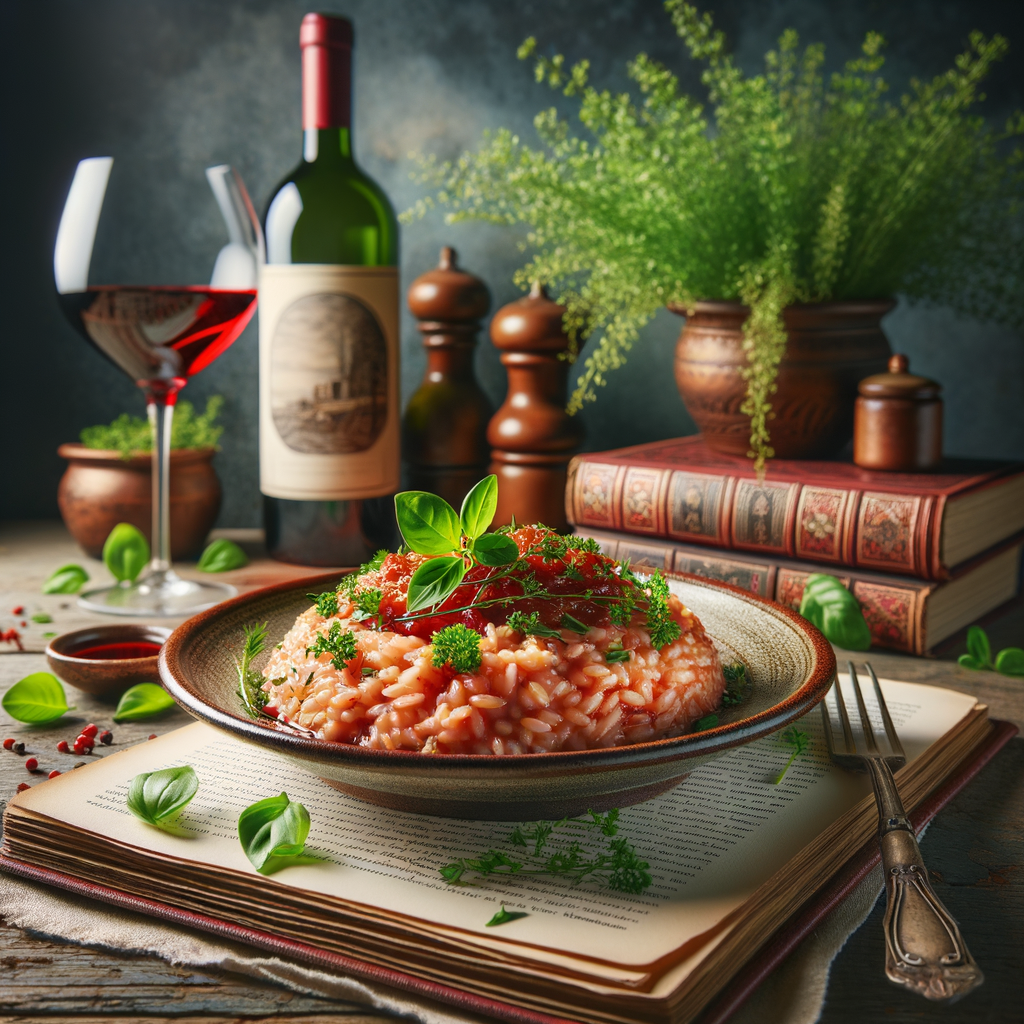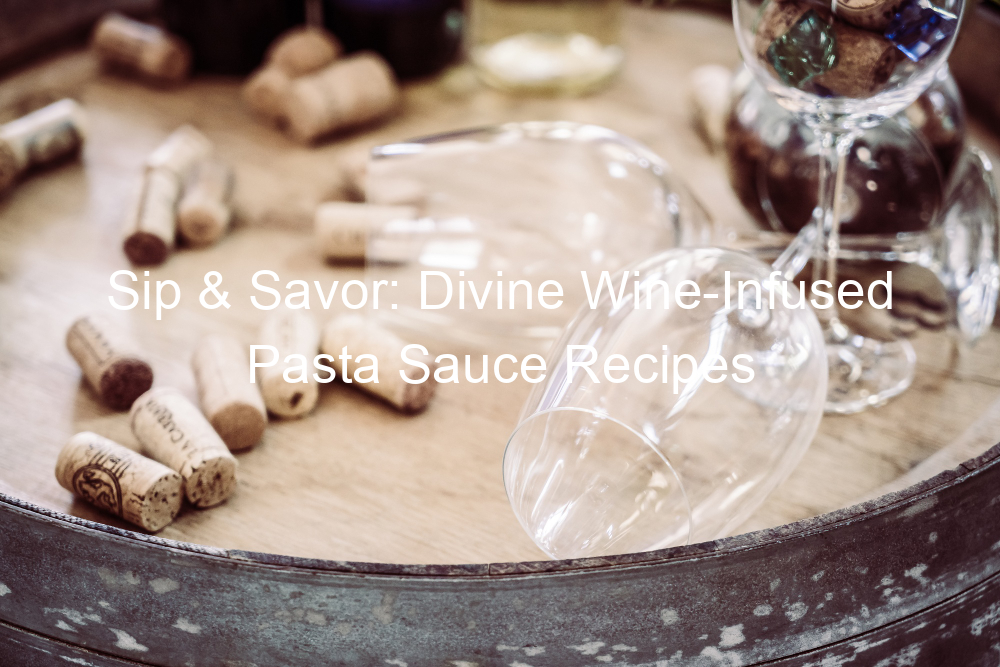
Introduction to Red Wine Risotto
Welcome to the exciting world of cooking with wine! Today, we’re going to introduce you to an Italian classic with a twist – Red Wine Risotto. This dish combines the creamy, comforting texture of risotto with the rich, complex flavors of red wine.
- Exploring the world of Italian Risotto Recipes
- The role of Red Wine in Cooking
Risotto is a traditional Italian dish that’s been around for centuries. It’s a type of rice dish cooked slowly with broth until it reaches a creamy consistency. There are many variations of risotto, each with its own unique flavor profile. Some popular types include Risotto alla Milanese, which is flavored with saffron, and Risotto al Barolo, which uses Barolo wine. But today, we’re focusing on a risotto recipe that uses red wine for a deep, robust flavor.
Red wine isn’t just for drinking – it’s also a fantastic ingredient in cooking. When used in recipes, red wine can add depth and complexity to the flavors of a dish. It can also help to tenderize meat, making it softer and more flavorful. In our Red Wine Risotto, the wine is used to infuse the rice with a rich, fruity flavor that complements the creaminess of the risotto.
Whether you’re a seasoned chef or a beginner in the kitchen, cooking with wine can open up a whole new world of flavors. So grab a bottle of your favorite red, and let’s get started on our Red Wine Risotto!
Understanding Risotto
Before we dive into the delicious world of red wine risotto, let’s first understand what risotto is.
What is Risotto?
Risotto is a creamy, comforting dish that originated from Italy. It’s a versatile meal that can be enjoyed as a main course or a side dish. But what makes risotto special? Let’s delve into its origin and key ingredients.
- Origin and history of Risotto
- Key ingredients in a traditional Risotto
Risotto has a rich history that dates back to the 14th century. It was in Northern Italy where this dish was first created. The humid climate in this region was perfect for growing short-grain rice, which is the main ingredient in risotto. The dish quickly gained popularity for its creamy texture and versatility. Learn more about the history of risotto on Wikipedia.
A traditional risotto is made with a few key ingredients. These include Arborio rice, a type of short-grain rice known for its ability to absorb liquid and create a creamy texture. Other ingredients include broth, butter, onions, and Parmesan cheese. The beauty of risotto is that you can add a variety of other ingredients to suit your taste, such as vegetables, meat, or in our case, wine!
Now that we have a basic understanding of risotto, we can explore how to enhance it with the rich flavors of red wine. Stay tuned for the next section!
Risotto Cooking Tips
When it comes to cooking risotto, there are a few key tips that can make all the difference. Here are the top three:
- Choosing the Right Rice
- Stirring Technique
- Importance of Stock
Not all rice is created equal, especially when it comes to risotto. The best types of rice for risotto are short-grain varieties like Arborio, Carnaroli, and Vialone Nano. These types of rice have a high starch content, which gives risotto its creamy texture. Arborio is the most common and easiest to find, but Carnaroli and Vialone Nano are often preferred by chefs for their superior texture and flavor.
Stirring is a crucial part of making risotto. It helps release the starch from the rice, which creates the dish’s signature creamy consistency. But be careful not to over-stir. You want to stir just enough to prevent the rice from sticking to the bottom of the pot and to ensure even cooking. A good rule of thumb is to stir every 2-3 minutes.
Stock is another key ingredient in risotto. It’s added gradually to the rice while it cooks, allowing the rice to absorb the liquid and flavors. For the best results, use a high-quality, flavorful stock. Homemade is best, but store-bought will work in a pinch. Just make sure it’s warm when you add it to the rice; cold stock can cause the rice to cook unevenly.
With these tips in mind, you’re well on your way to making a delicious, restaurant-quality risotto at home. Happy cooking!
Introducing Wine into Risotto
When you’re looking to add a unique twist to your traditional risotto, introducing red wine can be an exciting choice. Not only does it bring a rich, deep color to your dish, but it also imparts a robust flavor that can take your risotto to the next level.
Benefits of Cooking with Red Wine
Aside from the delightful taste, there are several benefits to cooking with red wine. Let’s explore a couple of them:
- Flavor enhancement: Red wine has a complex flavor profile that can enhance the taste of your risotto. It adds a depth of flavor that is hard to achieve with other ingredients. The alcohol in the wine evaporates during the cooking process, leaving behind a concentrated, rich flavor that complements the creaminess of the risotto.
- Health benefits: Red wine is known for its health benefits, thanks to its high antioxidant content. These antioxidants, particularly resveratrol and flavonoids, can help protect your heart and lower the risk of heart disease. When you cook with red wine, you get to enjoy these health benefits in your delicious risotto.
So, the next time you’re making risotto, consider adding a splash of red wine. It’s a simple way to enhance the flavor and add a touch of sophistication to your dish, all while reaping some health benefits. Stay tuned for our next section where we will discuss the best red wines to use for your risotto.
Best Red Wine for Risotto
Choosing the right red wine for your risotto can make a world of difference in your dish. Let’s explore how to understand wine profiles and some top wine recommendations for your next risotto.
- Understanding Wine Profiles
Wine profiles refer to the characteristics of a wine, such as its flavor, aroma, body, and acidity. Understanding these can help you choose the perfect wine for your risotto.
Flavor: This is the taste of the wine on your palate. Red wines can have flavors of red fruits, black fruits, or spices. For risotto, a wine with a fruity flavor works best.
Aroma: This is the smell of the wine. Red wines can have aromas of fruits, spices, or earthy notes. A wine with a fruity or spicy aroma can add depth to your risotto.
Body: This refers to the weight and fullness of the wine in your mouth. Full-bodied wines have a rich and robust flavor, while light-bodied wines are more delicate. For risotto, a medium to full-bodied wine is ideal.
Acidity: This is the tartness or sharpness of the wine. Wines with high acidity can balance the creaminess of a risotto.
- Top Wine Recommendations
Here are some top red wine recommendations for your risotto:
| Wine | Profile |
|---|---|
| Barbera | Fruity flavor, medium body, high acidity |
| Merlot | Black fruit flavors, full body, medium acidity |
| Pinot Noir | Red fruit flavors, light to medium body, high acidity |
Remember, the best wine for your risotto is one that you enjoy drinking. So, feel free to experiment and find your perfect match. Happy cooking!
Red Wine Risotto Recipe Ideas
Looking for a new way to spice up your dinner? Try these delicious and easy-to-make red wine risotto recipes. They’re sure to impress your guests and satisfy your taste buds.
Classic Red Wine Risotto
Our first recipe is a classic red wine risotto. This dish is a favorite in many Italian households, and once you try it, you’ll understand why. It’s rich, creamy, and full of flavor.
- Ingredients
- 1 cup Arborio rice
- 1/2 cup red wine
- 4 cups chicken broth
- 1/2 cup grated Parmesan cheese
- 1/2 cup chopped onion
- 2 cloves garlic, minced
- 2 tablespoons olive oil
- Salt and pepper to taste
- Step-by-step instructions
- Heat the olive oil in a large pan over medium heat.
- Add the onion and garlic and cook until they’re soft and fragrant.
- Add the Arborio rice and stir until it’s coated in the oil.
- Add the red wine and stir until it’s absorbed by the rice.
- Gradually add the chicken broth, stirring constantly, until the rice is tender and creamy.
- Stir in the Parmesan cheese and season with salt and pepper.
- Enjoy your delicious red wine risotto!
Here’s what you’ll need:
Follow these steps to make your red wine risotto:
That’s it! You’ve just made a classic red wine risotto. This dish is perfect for a cozy night in or a fancy dinner party. Don’t forget to pair it with a glass of your favorite red wine.
Gourmet Risotto Ideas
-
Red Wine and Mushroom Risotto
If you’re a fan of earthy flavors, this recipe is for you. The rich taste of mushrooms pairs perfectly with the robust flavor of red wine. The key to this recipe is to use a good quality red wine that you would enjoy drinking. The wine not only adds a deep color to the risotto but also a rich, complex flavor that is truly irresistible.
Don’t forget to sauté your mushrooms until they’re golden brown for the best flavor. And remember, risotto requires patience. Keep stirring and adding broth until the rice is creamy and al dente.
-
Red Wine and Sausage Risotto
For a hearty and satisfying meal, try this red wine and sausage risotto. The savory sausage and the rich red wine create a comforting and delicious dish. This recipe is perfect for a chilly evening when you want something warm and filling.
Choose a sausage that you love, as its flavor will permeate the risotto. And as with the mushroom risotto, be sure to choose a red wine that you enjoy drinking. The better the wine, the better your risotto will be!
-
Recap of key takeaways
Whether you choose to make the mushroom or sausage risotto, there are a few key things to remember. First, always use a wine that you enjoy drinking. Second, have patience. Risotto takes time to cook properly, but the result is worth it. And finally, don’t be afraid to experiment. Once you’ve mastered these recipes, try adding your own twist!
-
Encouragement to experiment with different Red Wine Risotto recipes
Now that you have these two delicious recipes in your arsenal, why not experiment with your own red wine risotto creations? You could try adding different vegetables, cheeses, or even spices. The possibilities are endless. Remember, the best part about cooking is making it your own. So, get creative and have fun!






